2. 中国地质大学地质过程与矿产资源国家重点实验室, 中国地质大学地球科学学院, 武汉 430074
2. State Key Laboratory of Geological Processes and Mineral Resources, and Faculty of Earth Sciences, China University of Geosciences, Wuhan 430074, China
印度板块和欧亚板块在大约70~50Ma发生的陆陆碰撞作用造就了全球最年轻、规模最大高原,其中在喜马拉雅带形成了巨大的淡色花岗岩带(Yin and Harrison, 2000),这些淡色花岗岩是研究喜马拉雅造山带构造-岩浆演化历史的重要“岩石探针”(莫宣学等,2003),因此引起众多学者的关注,并取得了很多成果(Harris and Massey, 1994; Harrison et al., 1997, 1998; Zhang et al., 2004; 张宏飞等, 2005; Guo and Wilson, 2012; Visona et al., 2012)。然而,有关这些淡色花岗岩的成因依然存在如下争议:(1) 淡色花岗岩的岩浆源区是什么?由于喜马拉雅淡色花岗岩显示非常富集的Nd-Hf同位素成分,被认为是由高喜马拉雅结晶岩系发生深熔作用而形成(Zhang et al., 2004;杨晓松和金振民,2001),杨晓松等人的实验结果支持高喜马拉雅的淡色花岗岩来自于结晶岩系中黑云斜长片麻岩的部分熔融作用(杨晓松等,2001);同时一些学者则认为高喜马拉雅结晶岩系中的含蓝晶石变泥质岩为岩浆源区(Deniel et al., 1987; Harris and Inger, 1992; Harris and Massey, 1994),还有学者认为喜马拉雅淡色花岗岩是由低喜马拉雅和高喜马拉雅岩系发生混合而成(Le Fort et al., 1987; Visonà and Lombardo, 2002; Guo and Wilson., 2012 ),其中Guo and Wilson (2012) 认为喜马拉雅中新世淡色花岗岩是由2%~19%的低喜马拉雅流体参与所形成的变质交代源区再经过7%~16%的部分熔融所形成。(2) 淡色花岗岩的形成条件是什么?目前国内外学者一般认为淡色花岗岩形成于压力较低(Searle et al., 2010; Visonà et al., 2012)、温度也较低(Harris and Massey, 1994; Zhang et al., 2004; 张宏飞等, 2005)的环境,其中根据夕线石包裹红柱石和堇青石的现象提出喜马拉雅淡色花岗岩形成于近等压的进变质熔融作用(Visonà and Lombardo, 2002),同时由于出现红柱石,喜马拉雅淡色花岗岩形成压力应小于400MPa(Visonà et al., 2012)。 (3) 喜马拉雅淡色花岗岩的形成模式是什么?目前主要包括流体参与的深熔作用(Le Fort et al., 1987; Harris et al., 1993; Patiño Douce and Harris, 1998)、减压熔融(Harris and Massey, 1994; Davidson et al., 1997)和剪切摩擦生热和放射性同位素生热所导致的过热熔融(Harrison et al., 1997, 1998, 1999; Visona and Lombardo, 2002)这三种模式,但理论计算表明单纯的地壳放射性元素生热和摩擦剪切生热都很难产生大规模的岩浆作用(石耀霖和王其允,1997; Nabelek and Liu, 2004)。上述结果表明对淡色花岗岩的成因,仍然需要从矿物学、岩石学和地球化学的角度开展进一步的研究。
本文选取高喜马拉雅淡色花岗岩带中的洛扎岩体,进行了锆石U-Pb定年和Hf同位素测试以及岩石元素和Sr-Nd同位素分析,试图进一步揭示淡色花岗岩的岩石特征、源区组成和形成机制。
1 地质背景和样品喜马拉雅构造带是印度大陆北缘的被动大陆边缘,其自北向南又可分为特提斯喜马拉雅、高喜马拉雅、低喜马拉雅以及西瓦里克前陆盆地等四个构造单元(图 1)(Yin and Harrison, 2000;Hodges, 2000; Yin, 2006)。特提斯喜马拉雅主要为寒武-新生代早期的沉积岩系,为印度大陆被动陆缘的碎屑与碳酸盐建造,部分地段岩石经历过低级变质作用和强烈变形作用的改造,它夹持于南侧的正断层藏南拆离系(Southern Tibetan Detachment System, STDS)和雅鲁藏布缝合带(Indus-Yalung Zangbo Suture Zone, IYSZ)之间。高喜马拉雅位于STDS以南,它主要由两套岩石组成,其一为原岩为泥质岩-镁铁质岩-钙硅酸岩的角闪岩相副变质岩系;其二为泛非期(~500Ma)或更早侵位的花岗岩(现已变质为花岗片麻岩,例如岗巴岩体, Quigley et al., 2008)。低喜马拉雅与高喜马拉雅被低角度的主中央逆冲断层(Main Central Thrust, MCT)分隔开来,它位于海拔较低的喜马拉雅山前,主要由低级到未变质的前寒武纪-古生代岩石组成。低喜马拉雅沿南侧的主边界逆冲断层(Main Boundary Thrust, MBT)逆冲在西瓦里克前陆盆地沉积之上,西瓦里克群前陆盆地沉积属于新生代沉积产物。
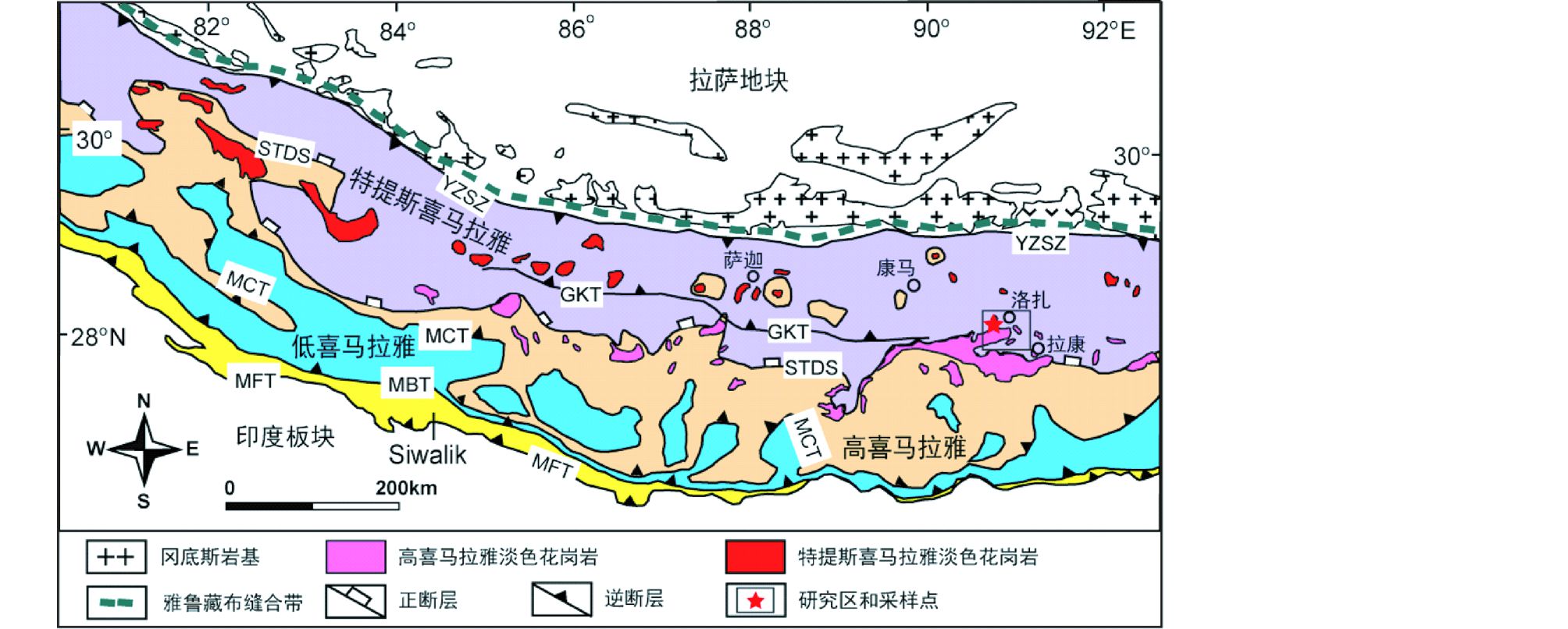
|
图 1 喜马拉雅造山带淡色花岗岩分布图(据Guo and Wilson, 2012 修改) YZSZ-雅鲁藏布缝合带;GKT-吉隆-康马逆冲断裂带;STDS-藏南拆离系;MCT-主中央逆冲断层;MBT-主边界逆冲断层;MFT-主前锋逆冲断层 Fig. 1 Sketch geological map of the leucogranite in Himalayan orogen (modified after Guo and Wilson, 2012) YZSZ-Yarlung Zangbo Suture Zone; GKT-Gyirong-Kangmar Thrust fault system; STDS-Southern Tibetan Detachment System; MCT-Main Central Thrust; MBT-Main Boundary Thrust; MFT-Main Frontal Thrust |
淡色花岗岩主要沿近东西向分布于特提斯喜马拉雅和高喜马拉雅带上,构成了世界上最大的淡色花岗岩带。特提斯喜马拉雅淡色花岗岩(THL)主要呈岩株侵位于特提斯穹窿之中,而高喜马拉雅淡色花岗岩(HHL)主要紧靠STDS呈不连续产出于高喜马拉雅结晶基底上部(Searle et al., 1997; Schneider et al., 1999; Visona and Lombardo, 2002)。
本文研究区位于高喜马拉雅东端的洛扎地区(图 1),区内分布了大量电气石花岗岩,岩性包括电气石二云母花岗岩和电气石白云母花岗岩。其中电气石二云母花岗岩为中粗粒-不等粒结构,局部可见云母定向排列,矿物以石英、钾长石、斜长石、白云母、黑云母为主,含少量的磷灰石、锆石、石榴子石、独居石、磷钇矿等副矿物,少数含有磁铁矿等;镜下石英具有波状消光现象,斜长石可见聚片双晶及卡氏双晶,部分可见环带,钾长石可见文象结构和包含结构。白云母局部可见由于构造应力作用而造成的塑性变形现象(图 2a, b)。电气石白云母花岗岩具有相似的结构和构造,矿物组成以斜长石、钾长石、石英、电气石,白云母为主,含少量磷灰石、锆石、石榴子石等副矿物;镜下斜长石呈厚板状,可见聚片双晶和卡纳复合双晶,双晶有时可见扭折现象,局部可见长石蚀变而形成的绢云母化(图 2c, d)。电气石呈长柱状,深棕色,长3~6mm,表面具有裂纹,有一定的多色性。
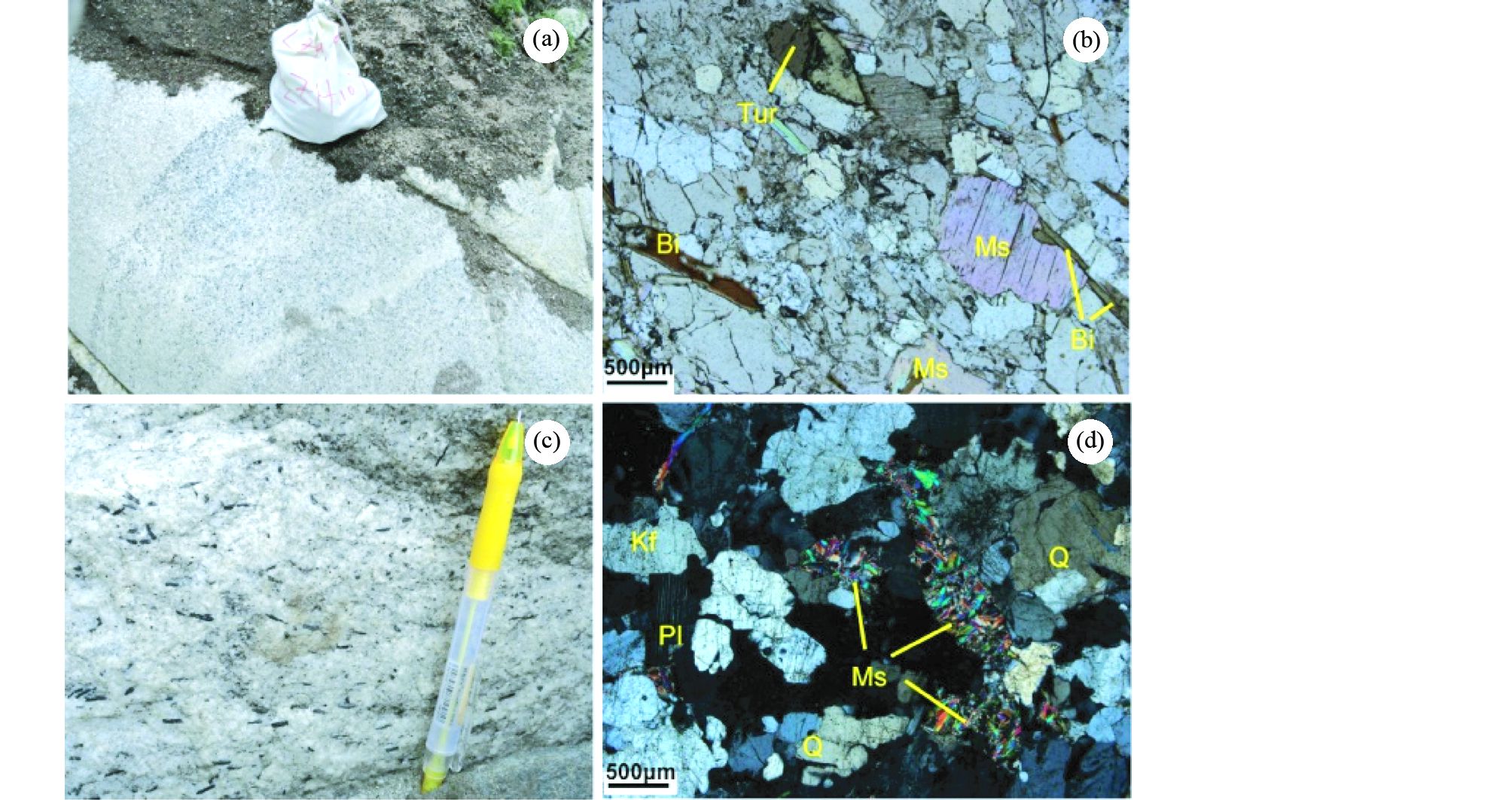
|
图 2 电气石二云母花岗岩(a、b)和电气石白云母花岗岩(c、d)的野外及显微照片 Fig. 2 Photographs showing outcrop and macrostructure features of the tourmaline bearing two-mica leucogranite (a, b) and tourmaline bearing muscovite leucogranite (c, d) |
野外采集样品经挑选较新鲜部分碎至200目,在中国地质大学(北京)地质过程与矿产资源国家重点实验室完成主量元素、在中国地质大学(武汉)地质过程与矿产资源国家重点实验室完成微量元素测定。主量元素采用 Leeman Labs. Inc 公司Prodigy 型全谱直读型发射光谱仪(ICP-AES)测定,分析精度优于5%,微量元素采用 Agilent 7500a等离子体质谱仪(ICP-MS)测定,分析精度优于5%~10%。微量元素测试详细的样品处理过程、分析精密度和准确度见Liu et al. (2008) 。主、微量元素测试结果见表 1。
|
|
表 1 洛扎淡色花岗岩主量元素(wt%)和微量元素(×10-6)数据 Table 1 Major(wt%) and trace element (×10-6) data of the Luozha leucogranite |
全岩Sr、Nd同位素的化学分离在北京大学造山带与地壳演化教育部重点实验室完成,测试在天津地质矿产研究所同位素实验室利用Triton热电离质谱仪(TIMS)完成,测定的87Sr/86Sr和143Nd/144Nd比值分别采用87Sr/86Sr=0.1194和143Nd/144Nd=0.7219进行质量分馏校正,分析期间Sr国际标准NBS987给出87Sr/86Sr=0.710234±0.000008(2σ,n=5),Nd国际标准LRIG给出143Nd/144Nd=0.512192±0.000005(2σ,n=5),实验室监控标准BCR-2给出87Sr/86Sr=0.7104993±0.000006(2σ,n=6),143Nd/144Nd=0.5126632±0.000002(2σ,n=6),详细的Sr-Nd同位素分析流程见Niu et al. (2012) 。本文Sr-Nd同位素结果见表 1。
2.3 锆石U-Pb定年和Hf同位素用常规方法挑选的锆石制成环氧树脂样品靶,经过打磨抛光使锆石露出中心后进行透射光、反射光和阴极发光(CL)显微照相。阴极发光在中国科学院地质与地球物理研究所电子探针实验室完成,加速电压为15kV。锆石U-Pb同位素定年在中国地质科学院矿产资源研究所使用Finnigan Neptune型LA-MC-ICP-MS及与之配套的Newwave UP 213激光剥蚀系统完成。激光剥蚀所用斑束直径为25μm,频率为10Hz,能量密度约为2.5J/cm2,He为载气。207Pb/206Pb、206Pb/238U、207Pb/235U的测试精度(2σ)均为2%左右。锆石U-Pb定年以锆石GJ-1为外标,测试过程中在每测定5~7个样品前后重复测定两个锆石GJ-1对样品进行校正,并测量一个锆石Plesovice,观察仪器的状态以保证测试的精确度。数据处理采用ICPMSDataCal程序(Liu et al., 2010),测量过程中绝大多数分析点206Pb/204Pb>1000, 未进行普通铅校正。锆石年龄谐和图用Isoplot 3.0程序获得。详细测试方法参见侯可军等(2009) ,测试结果见表 2。锆石Hf同位素测试的剥蚀直径为55μm,使用锆石国际标样GJ-1和Plesovice作为参考物质,Hf分析点与U-Pb定年分析点一致。Hf同位素分析流程详见侯可军等(2007) ,测试结果见表 3。
|
|
表 2 洛扎淡色花岗岩锆石U-Pb年龄数据 Table 2 Zircons U-Pb isotope data of the Luozha leucogranite |
|
|
表 3 洛扎淡色花岗岩锆石Hf同位素数据 Table 3 Zircon Hf isotope data of Luozha leucogranite |
洛扎淡色花岗岩均具有富硅(SiO2为72.75%~74.62%)、富铝(Al2O3为14.45%~15.48%),铝饱和指数(A/CNK)为1.1~1.2,属强过铝质花岗岩(图 3a),根据 CIPW 标准矿物计算,标准刚玉分子含量均大于 1%,说明样品中Al2O3过饱和(表 1),这些与样品中含有大量富铝的原生矿物(如白云母、电气石)一致。但相比于喜马拉雅带以及冈底斯带的淡色花岗岩,洛扎淡色花岗岩的Al2O3含量略偏低。K2O+Na2O含量较高(8.11%~8.92%),洛扎淡色花岗岩属于高钾钙碱性系列(图 3b)。
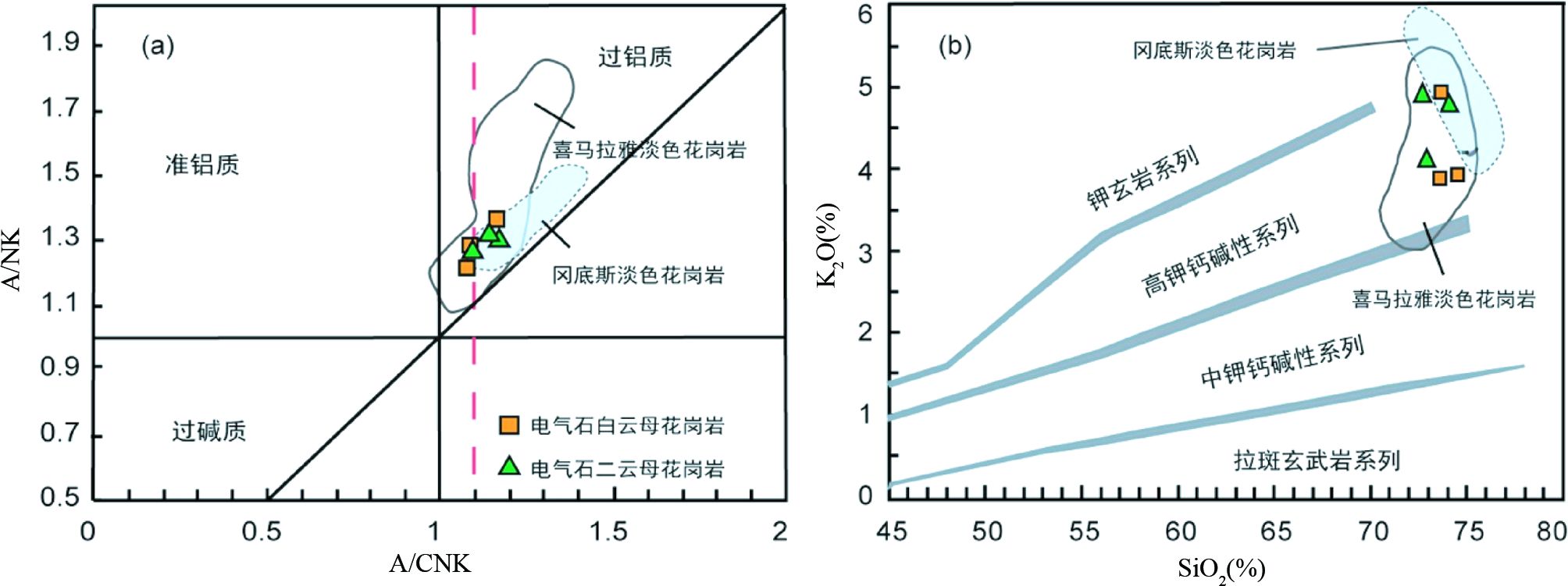
|
图 3 洛扎淡色花岗岩A/NK-A/CNK图解(a, 据Ma et al., 1989)和SiO2-K2O图解(b, 据Le Maitre, 2002) 喜马拉雅淡色花岗岩数据张宏飞等(2005) 和Guo and Wilson (2012) ;冈底斯淡色花岗岩翟庆国等(2005) 和张宏飞等(2007) Fig. 3 The A/NK-A/CNK diagram (a, after Ma et al., 1989) and SiO2-K2O diagram (b, after Le Maitre, 2002) of the leucogranite in Luozha Data source: Himalayan leucogranite from Zhang et al.(2005) , Guo and Wilson (2012) ; Gangdese leucogranite from Zhai et al.(2005) , Zhang et al.(2007) ; other data from this work |
洛扎淡色花岗岩的稀土元素表现为轻稀土明显富集,轻重稀土分异明显,(La/Yb)N平均值为23.5(图 4a);具有明显的Eu负异常(Eu/Eu*=0.57)。样品强烈富集Rb、U、Pb、K等大离子亲石元素,相对亏损Nb、Ta、Zr、Ti等高场强元素(图 4b)。与冈底斯淡色花岗岩相对比,洛扎淡色花岗岩的稀土总量较低,在整个喜马拉雅带上对比,洛扎淡色花岗岩稀土含量偏少,且重稀土亏损更明显(图 4a, b)。
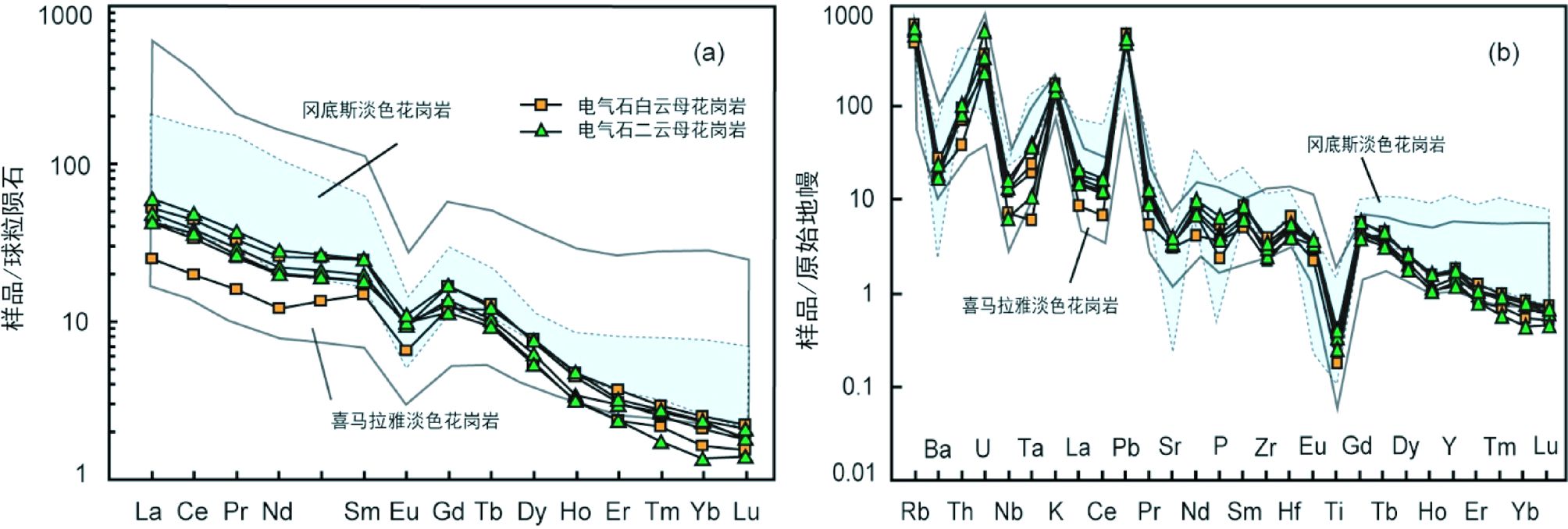
|
图 4 洛扎淡色花岗岩稀土元素球粒陨石标准化(a)和微量元素原始地幔标准化配分图(b)(标准化值据Sun and McDonough, 1989) 阴影显示的文献数据来源同图 3 Fig. 4 Plots of chondrite-nomalized REE (a) and primitive mantle-normalized trace elements (b) for the Luozha leucogranite (normalizing data after Sun and McDonough, 1989) The data sources of shaded are same as Fig. 3 |
本文对电气石白云母花岗岩(LZH1101)进行了U-Pb定年。锆石多呈长柱状,颗粒大小具有较大的差别,长度介于220~90μm之间,长宽比为1:2~1:3,颗粒较大的锆石多含有继承锆石,锆石发育震荡环带(图 5),其中本次岩浆事件的锆石具有比较细密的环带,明显区别于包裹在锆石中央的早期岩浆锆石(例如图 5中的430Ma和743Ma)。
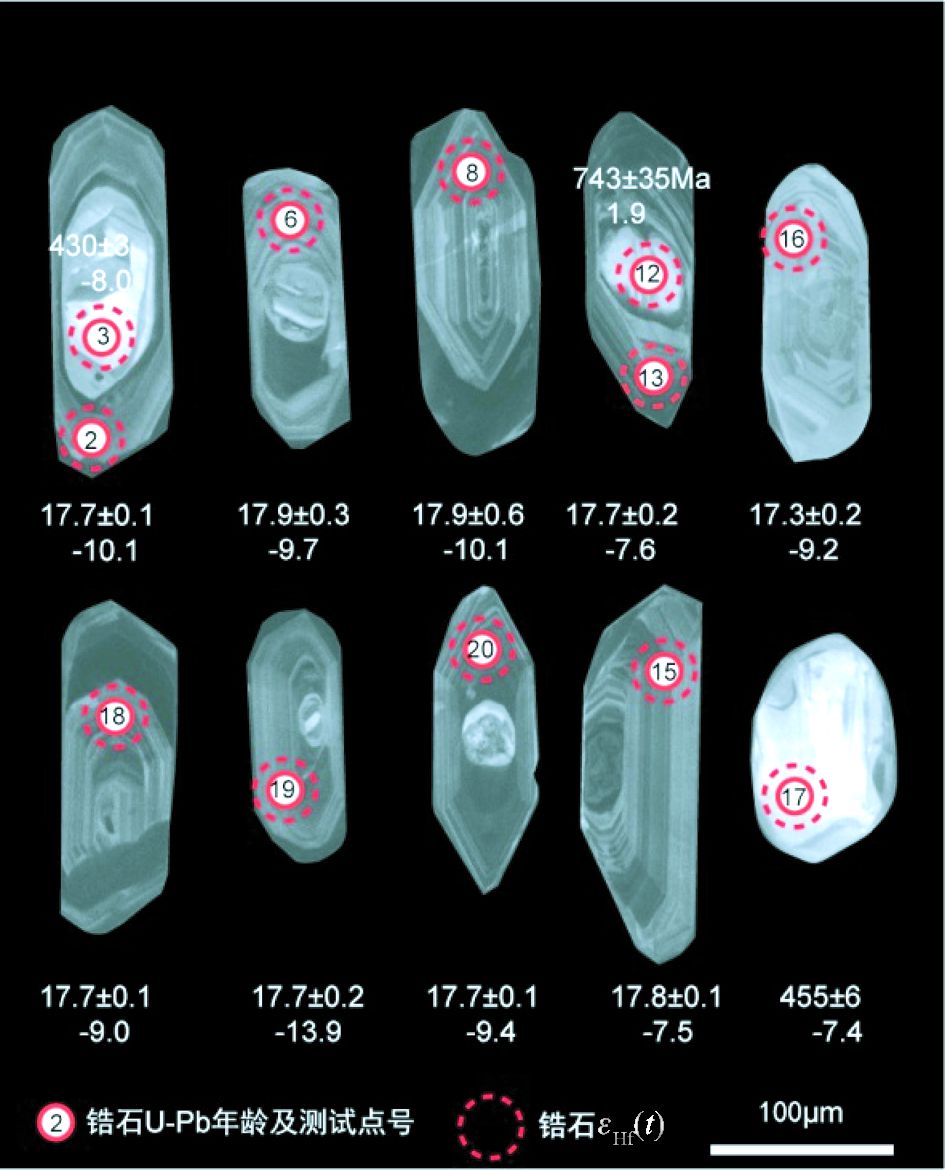
|
图 5 洛扎淡色花岗岩的代表性锆石阴极发光图像 Fig. 5 Representative CL images of zircons from Luozha leucograntes |
样品LZH1101共完成20点分析(图 6),除14号点偏离谐和线较远,予以剔除外,其余点几乎都位于谐和线上,其中16个测点数据代表本次岩浆事件,这16个分析点的Th/ U为0.06~0.1,明显低于典型岩浆锆石,其Th/U比值一般大于0.4(吴元保和郑永飞,2004)。获得的年龄介于17.3~17.9Ma之间,加权平均年龄值为17.7±0.1Ma(2σ),MSWD为0.83,代表了洛扎电气石白云母花岗岩的结晶年龄。另外3个测点Th/U含量较高,在0.09~2.15之间,2个年龄为古生代年龄,1个为新元古代年龄,可能为来源于古老基底的继承锆石。
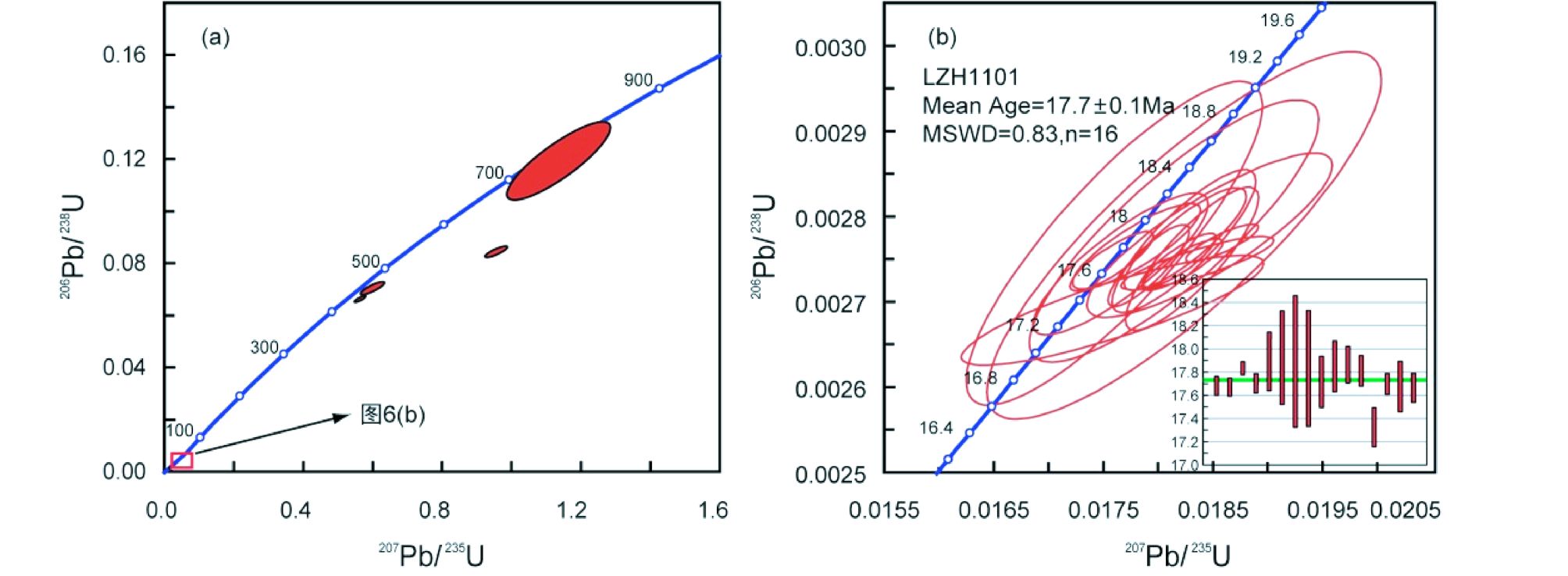
|
图 6 洛扎地区淡色花岗岩锆石U-Pb年龄谐和图 Fig. 6 U-Pb concordia diagrams of the Luozha leucogranites |
将样品LZH1101中U-Pb分析得到的年龄谐和率达到90%的点进行了锆石Hf同位素测试,共测试了19个点。样品的176Hf/177Hf值变化范围为0.282285~0.282550,其中上述的平均年龄为17.7±0.1Ma的16颗岩浆事件的锆石εHf(t)的变化范围为-13.9~-7.5(图 7a, b),说明淡色花岗岩的岩浆来自于富集源区,而变化较大的εHf(t)值(大于6个单位),可能暗示了岩浆并非来源于均一源区。176Lu/177Hf值为0.000193~0.0015416,Hf亏损地幔两阶段模式年龄tDM2的变化范围为1.58~2.0Ga。
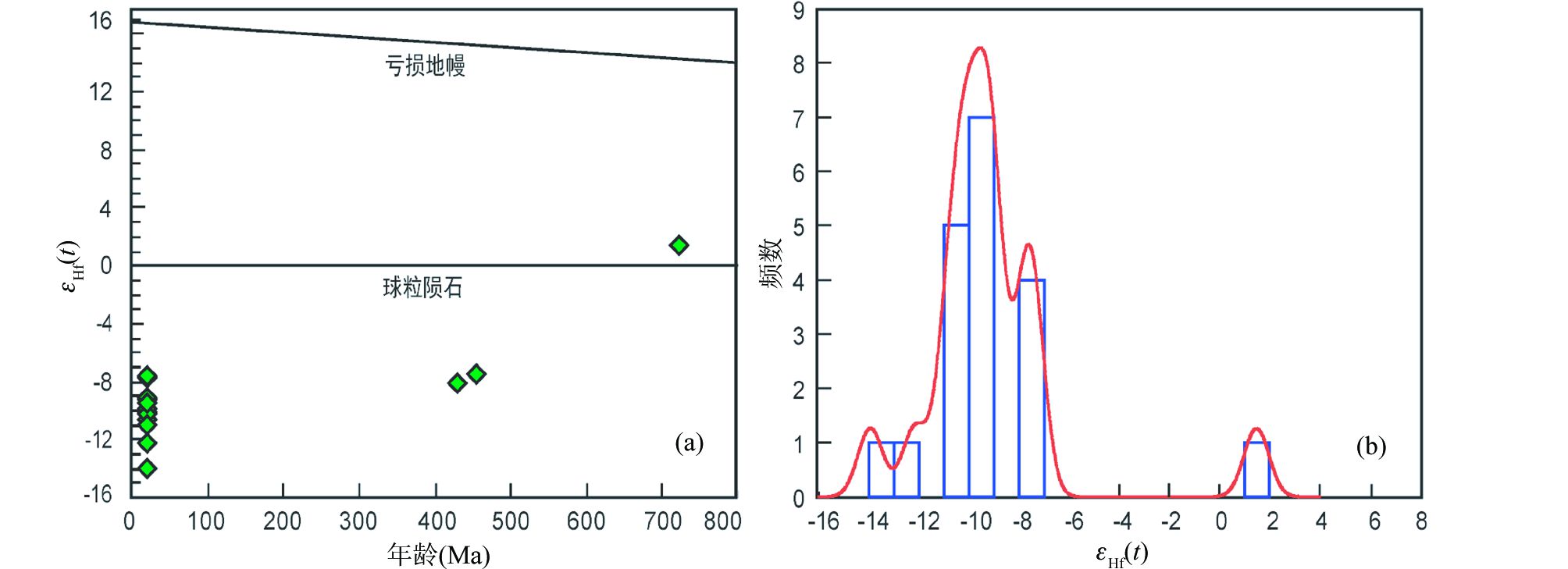
|
图 7 洛扎淡色花岗岩锆石εHf(t)-t图(a)和εHf(t)变化频数图(b) Fig. 7 Plots of εHf(t)-t (a) and histogram of εHf (t) (b) of the Luozha leucogranite |
所分析的3个淡色花岗岩样品以t=18Ma经过年龄校正后,(87Sr/86Sr)t和εNd(t)值分别为0.725802~0.727276和-13.4~-12.9,Nd同位素二阶段模式年龄为1.88~1.92Ga(表 1)。三个样品的Sr、Nd初始同位素比值变化不大,表明样品应为同源,岩石相对较高Sr初始比值和较低的εNd(t)值,说明岩浆应来源于古老地壳,这与前述Hf同位素结果一致。
4 讨论 4.1 喜马拉雅带淡色花岗岩的时代早期研究发现喜马拉雅淡色花岗岩的年龄主要为中新世,但近年研究也发现了时代为渐新世、始新世的年龄,其中特提斯喜马拉雅东段也拉香波、确定、打拉等地,获得了42Ma左右的淡色花岗岩结晶年龄(戚学祥等,2008;Zeng et al., 2011);在特提斯喜马拉雅西段仲巴-萨嘎交界处获得了44.8±2.6 Ma的淡色花岗岩体年龄(Ding et al., 2005),因此特提斯喜马拉雅淡色花岗岩年龄跨度为44~10Ma之间(张宏飞等,2005);在高喜马拉雅,吉隆地区发现同变形花岗岩具有约34Ma 的形成年龄(杨雄英等,2009),综合起来高喜马拉雅淡色花岗岩的形成时代跨度为34~12Ma(Schärer et al., 1986;Harris and Massey, 1994; Harris et al., 1995; Harrison et al., 1997)。本文获得的洛扎淡色花岗岩17.7±0.1Ma的年龄,属于中新世的淡色花岗岩的主要形成期。
4.2 岩石形成的温度和压力锆石广泛存在于花岗质岩石中,锆石的Zr饱和温度计是限定地壳深熔成因的花岗岩的重要工具(Watson and Harrison, 1983)。锆石是花岗质岩浆体系中较早结晶的副矿物,因而可以认为锆石饱和温度可近似代表花岗质岩石近液相线的温度(King et al., 1997)。锆石中Zr的分配系数对温度十分敏感,而其他因素对其没有明显影响(Miller et al., 2003),根据前人的Zr溶解度实验结果表明,锆石在岩浆中的溶解度满足方程(Watson and Harrision, 1983):
InDzrZircon/Melt={-3.8-[0.85(M-1)]}+12900/T
其中DzrZircon/Melt是Zr在锆石和岩浆中浓度的比值,T为绝对温度,M是阳离子含量的比值,由公式(Na+K+2Ca)/(Al×Si)来计算。
研究表明如果岩浆中Zr不饱和,Zr饱和温度计所给出的Zr饱和温度(TZr)为初始岩浆温度的下限;而如果岩浆中Zr达到饱和状态,所给出的Zr饱和温度为初始岩浆温度的上限(Miller et al., 2003)。如果已知成分及Zr含量,可以根据公式来计算锆饱和温度(Miller et al., 2003):
TZr=12900/[2.95+0.85M+Ln(496000/Zrmelt)]
依据上述公式计算,获得洛扎淡色花岗初始岩浆温度为650~693℃(表 1、图 8),其中电气石白云母花岗岩(平均温度为669℃)与电气石二云母花岗岩(平均温度为671℃)未显示明显区别。由于锆石CL图显示,锆石多具有继承锆石,说明岩浆中Zr已经达到了饱和状态(Harrison et al., 2007), 所以,锆饱和温度计所给出的温度是初始岩浆温度的上限,也就是说,岩浆的初始温度不超过650~693℃。从整个喜马拉雅带上来看,洛扎淡色花岗岩的初始岩浆温度相对较低,而冈底斯带的淡色花岗岩形成的温度高于喜马拉雅淡色花岗岩。
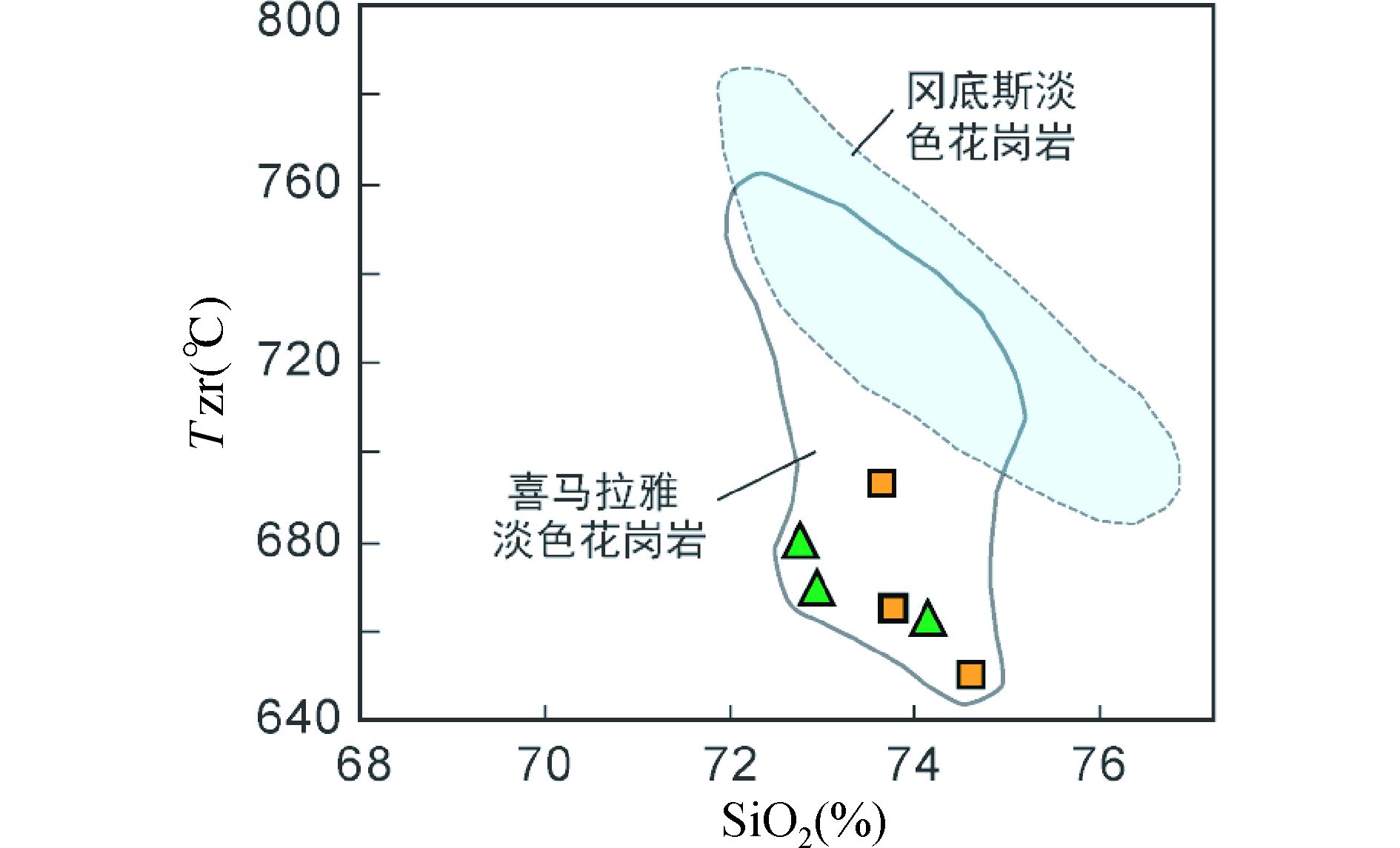
|
图 8 洛扎淡色花岗岩的SiO2-TZr图 引用数据及图例同图 3 Fig. 8 Plots of zircon TZr against whole rock SiO2 content of Luozha leucogranite The data sources and legends are same as Fig. 3 |
花岗岩的形成受熔体-矿物相平衡的制约(邓晋福等,2004),根据样品岩相学观察,石英与碱性长石颗粒大小相当,说明它们大致是同时结晶的,因此它们形成时必定位于同结线上。根据Qz-Ab-Or图(图 9),洛扎淡色花岗岩在形成时的压力大致为2~4kb,这与Visonà et al. (2012) 根据高喜马拉雅淡色花岗岩中红柱石的出现得到的红柱石淡色花岗岩形成压力为小于4kb的结果相一致。根据压力可推断洛扎淡色花岗岩侵位深度不超过约12km,属于上地壳范围。
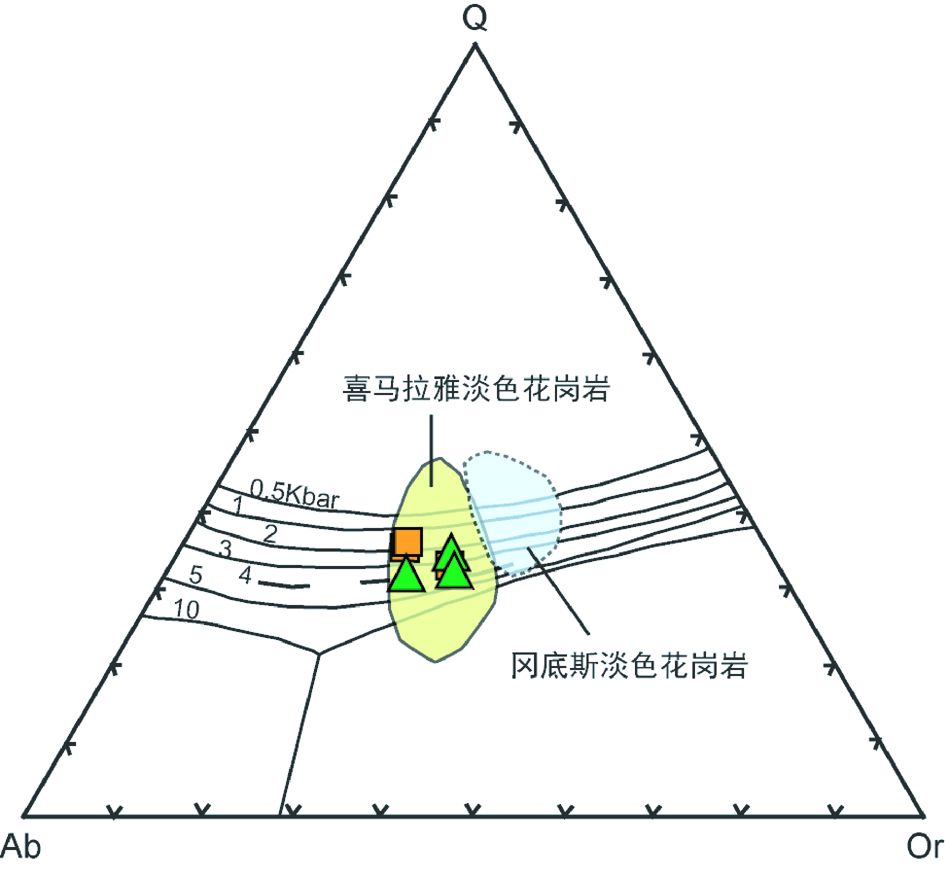
|
图 9 洛扎淡色花岗岩形成压力的Q-Ab-Or相图(据邓晋福,1987) 引用数据及图例同图 3 Fig. 9 The Q-Ab-Or phase diagram of the leucogranite in Luozha(after Deng, 1987) The data sources and legends are same as Fig. 3 |
一般认为,高喜马拉雅淡色花岗岩为高喜马拉雅结晶岩系中云母片岩或副片麻岩类的深熔作用的产物(Harris and Inger, 1992; Harrison et al., 1999; 郭素淑和李曙光, 2007)。洛扎地区淡色花岗岩的铝饱和指数(A/CNK)均大于或等于1.1,且根据CIPW标准矿物计算,标准刚玉(C)分子含量均大于 1%,属于强过铝质花岗岩,根据Barbarin 对花岗岩类的划分,应属于含白云母过铝质花岗岩(MPG)(Barbarin, 1999)。过铝质花岗岩的CaO与Na2O含量与其源岩密切相关,其比值的差异反映了源岩中泥质含量的高低(Chappell and White, 1992)。实验岩石学证明,与富斜长石贫泥质的砂质源岩形成的熔体比较,贫斜长石富泥质的源岩形成的过铝质熔体趋向于具有更低的CaO/Na2O比值(Patiño Douce and Johnston, 1991; Skjerlie and Johnston, 1996),因此泥质源岩形成的过铝质花岗岩的CaO/Na2O比值要低于砂质源岩形成的过铝质花岗岩,一般要小于0.3(Sylvester, 1998)。根据计算,洛扎淡色花岗岩的CaO/Na2O比值在0.19~0.26之间,小于0.3,推测其源岩可能为泥质岩。
除了CaO与Na2O对源岩具有一定指示作用外,微量元素Rb、Ba、Sr主要富集于云母和长石中,Rb/Ba、Rb/Sr体系也是反映源岩性质的重要参数(Sylvester, 1998)。本文6个淡色花岗岩样品均属于泥质来源,与前述推测结果一致(图 10)。
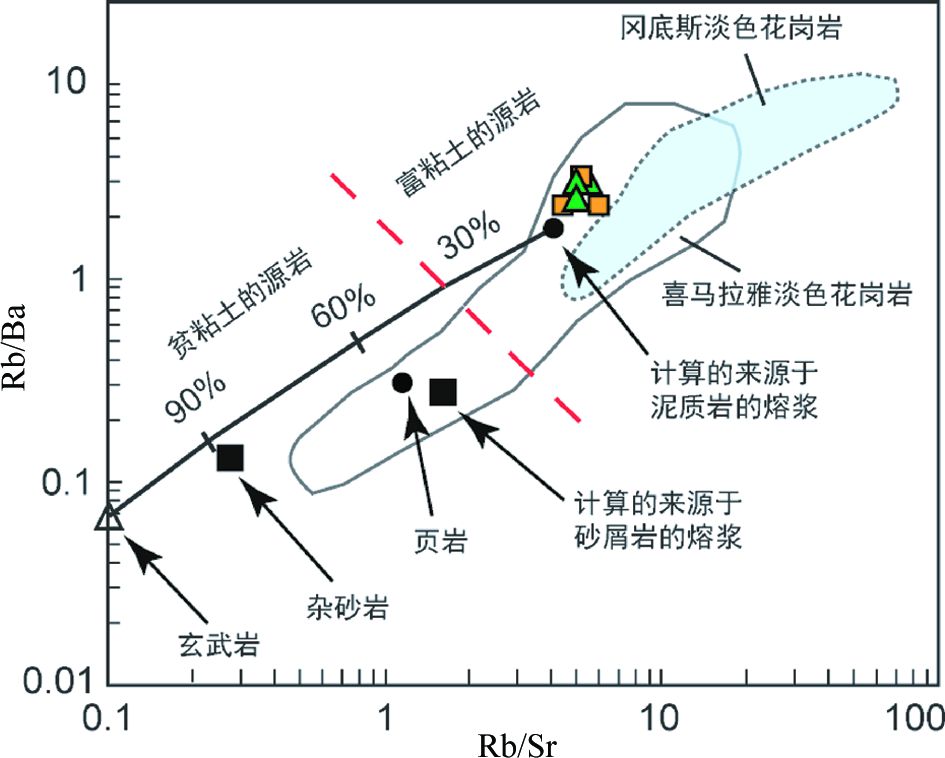
|
图 10 洛扎淡色花岗岩Rb/Ba-Rb/Sr图(据Sylvester,1998) 引用数据及图例同图 3 Fig. 10 Plot of Rb/Ba vs. Rb/Sr of the Luozha leucogranite (after Sylvester,1998) The data sources and legends are same as Fig. 3 |
尽管洛扎淡色花岗岩的源岩主要来自于泥质源区,但是其εHf(t)变化范围超过了6个单位,这暗示了岩浆源区可能经历过类似于岩浆混合的过程(Ji et al., 2009; 朱弟成等,2009),也可能代表了源区泥质岩石在同位素特征上是不均一的。本文将可能的泥质源区包括特提斯喜马拉雅的沉积岩、冈底斯地块片岩和片麻岩以及高喜马拉雅结晶岩系的Sr-Nd同位素资料综合起来(时间校正到18Ma)表示在图 11中。本文3个样品和文献的4个洛扎淡色花岗岩样品主要落在高喜马拉雅结晶岩系区域,表明喜马拉雅淡色花岗岩的源岩主要为高喜马拉雅结晶岩系中的变泥质岩。但是从图 11中可以看到,喜马拉雅带的基底岩石确实具有较为宽泛的Sr-Nd同位素成分范围,同时也可以发现,洛扎淡色花岗岩前文述及的较大的Hf同位素成分变化,也与高喜马拉雅基底岩石成分的不均一特征是一致的。
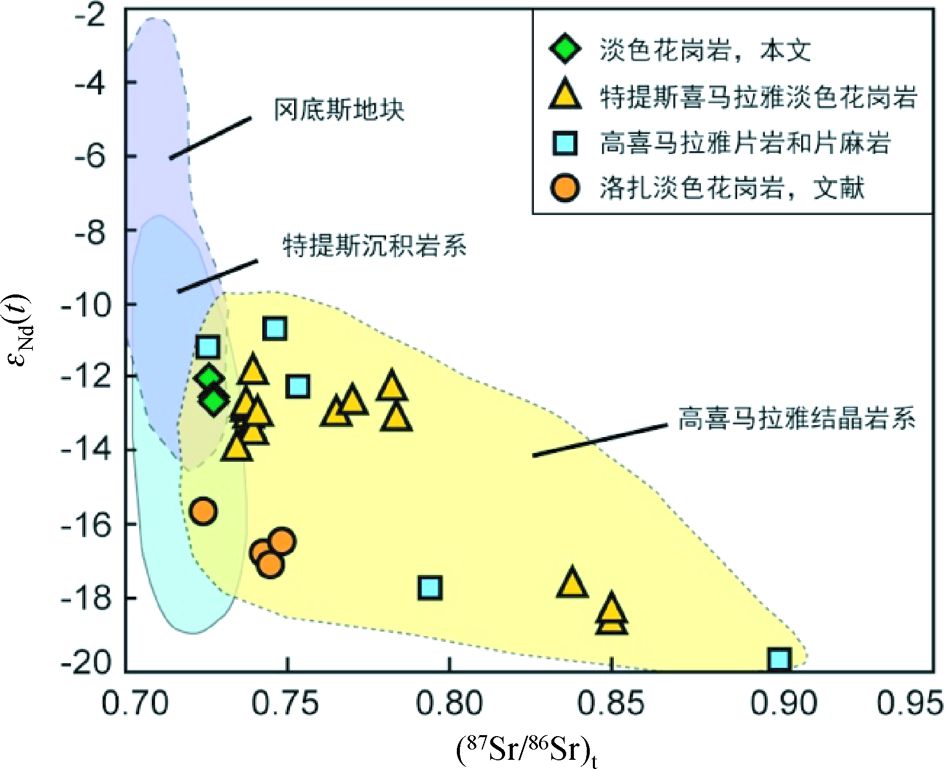
|
图 11 洛扎淡色花岗岩Sr-Nd同位素成分 数据来源:冈底斯地块片岩和片麻岩、特提斯沉积岩系和高喜马拉雅结晶岩系:Ahmad et al. (2000) ; Richards et al. (2005) ; Zhang et al. (2004) ; Zhang et al. (2010) ; Zhu et al. (2009a); King et al. (2011) , 朱弟成等(2009) ; 杨晓松等(2001) . 特提斯喜马拉雅淡色花岗岩: 张宏飞等(2004) ;洛扎淡色花岗岩: Guo and Wilson (2012) Fig. 11 Plots of isotopes of Sr against Nd of Luozha leucogranite Data sources: Schist and gneisses from Gangdise area, Tethyan Sedimentary Series and High Himalayan crystalline Series are from Ahmad et al. (2000) ; Richards et al. (2005) ; Zhang et al.(2004, 2010); Zhu et al.(2009a, b); King et al. (2011) and Yang et al. (2001) ; Tethyan Himalayan leucogranites: Zhang et al. (2004) ; Luozha leucogranite: Guo and Wilson (2012) |
高喜马拉雅淡色花岗岩被认为是在缺乏外加流体条件下,源岩中白云母或黑云母的脱水反应导致的脱水熔融作用形成的(Harris and Inger, 1992; Harris et al., 1995; Patiño Douce and Harris, 1998; Vielzeu and Schmidt, 2001)。实验表明,在其他条件相同的情况下,白云母分解温度低于黑云母的分解温度(Patiño Douce and Harris, 1998)。根据上文的Zr饱和温度计算,洛扎淡色花岗形成温度较低,更可能是白云母脱水反应,而微量元素模拟和实验研究发现,高喜马拉雅淡色花岗岩主要是白云母脱水熔融产生的(Inger and Harris, 1993;Patiño Douce and Harris, 1998)。根据Rb/Sr-Ba图解(图 12)可得,喜马拉雅淡色花岗岩的Rb/Sr与Ba没有呈现正的相关性,表明洛扎淡色花岗岩也是由白云母脱水熔融产生。
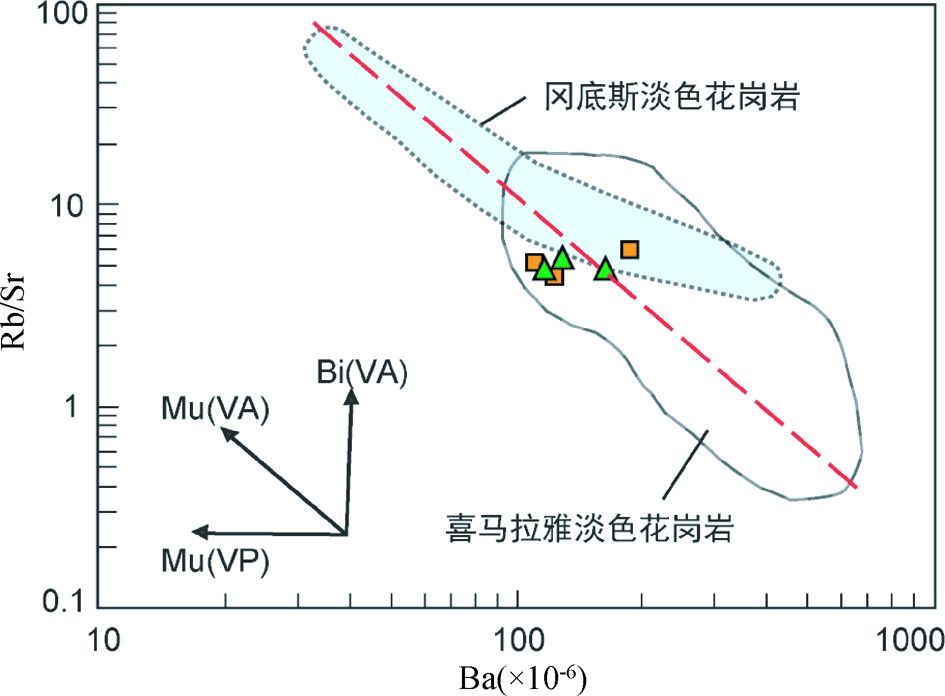
|
图 12 洛扎淡色花岗岩全岩Rb/Sr-Ba图(据张宏飞等,2005) Mu(VA)-缺乏蒸汽相的白云母熔融反应;Bi(VA)-缺乏蒸汽相的黑云母熔融反应;Mu(VP)-饱和蒸汽相的白云母熔融反应.引用数据及图例同图 3 Fig. 12 Rb/Sr-Ba vs. Ba diagram for the leucogranite in Luozha(after Zhang et al., 2005) The data sources and legends are same as Fig. 3 |
洛扎淡色花岗岩具有较高的Rb/Sr比值(Rb/Sr>4),高Rb/Sr比值的原因是由于岩石中富集Rb的同时,强烈的亏损Sr(含量仅为63.5×10-6~83.9×10-6)。由于Rb主要赋存于云母类矿物中,而Sr主要赋存于斜长石中,已有研究表明在有自由流体参与的地壳部分熔融过程中,长石熔融量将远远大于云母,例如,在水饱和情况下,矿物组合白云母+斜长石+石英反应产生的熔体的Rb/Sr比值仅大于1.5(Harris et al., 1995),这也进一步证实洛扎淡色花岗岩是在缺乏流体相的条件下,变泥质源岩中的白云母发生脱水熔融而产生。本文前文获得了洛扎淡色花岗岩形成温度为650~693℃、压力为2~4kb,与电气石淡色花岗岩在不饱和水的岩浆中结晶的压力(约3~4kb, Inger and Harris, 1993)一致。因此洛扎淡色花岗岩应是在上地壳浅部通过变泥质岩源岩中白云母脱水熔融形成的岩浆结晶后形成的。
4.5 构造动力学意义高喜马拉雅淡色花岗岩形成的构造背景一直以来都是争论的焦点。张金阳等人认为高喜马拉雅淡色花岗岩主要沿STDS的主要拆离断层分布指示了基底的隆升(张金阳和廖群安,2004);杨晓松等人倾向于认为淡色花岗岩是碰撞造山后地壳伸展导致的快速隆升和减压熔融的产物(杨晓松等,2001)。Harris and Massey (1994) 认为高喜马拉雅淡色花岗岩的形成与位于MCT和STDS之间的高喜马拉雅构造楔的迅速折返造成的减压环境有关。
由于淡色花岗岩是源于自身含水矿物分解导致的部分熔融,其形成的温度和压力成为决定性因素。上文述及,洛扎淡色花岗岩的结晶时的条件是650~693℃和2~4kb的温压条件,而岩石发生部分熔融作用的条件一定不低于上述的岩石结晶的稳压条件。对于印度板块北缘的喜马拉雅造山带来说,高于650~693℃中、上地壳的温度如何形成的?是MCT剪切摩擦的构造生热、地壳岩石放射性同位素衰变产热、还是岩石圈拆沉引起的软流圈上涌的深部热源?其中岩石圈拆沉作用应是发生在地壳显著加厚之后的减薄过程,喜马拉雅地区依然具有加厚的地壳,且目前野外依然无法找到与淡色花岗岩密切相关的幔源岩浆作用,因此不存在岩石圈减薄和软流圈上涌作用的证据;而理论计算表明单纯的地壳内放射性元素生热和摩擦剪切生热很难产生大规模的岩浆作用(石耀霖和王其允,1997; Nabelek and Liu, 2004)。因此,淡色花岗岩原生岩浆在含水矿物脱水的同时,压力减小就是十分必要的条件。已有研究表明STDS强烈活动的时间为17~20Ma(Copeland et al., 1987; Hubbard and Harrison, 1989, Hodges et al., 1992)。STDS的启动不仅使深部压力减小,还为岩浆提供了良好上侵的通道,这也同时解释了高喜马拉雅淡色花岗岩主要沿STDS主拆离断层分布的特征。洛扎淡色花岗岩的结晶年龄为17.7Ma,正好处于STDS强烈活动的时期。同时17~20Ma也是该地区快速隆起的时期,平均隆起速率大于2mm/a(Searle and Godin, 2003)。从构造-岩浆的角度综合考察,STDS的活动促使了高喜马拉雅地区的快速隆起,产生淡色花岗岩,使喜马拉雅地区从挤压背景过渡到了伸展垮塌背景。因此洛扎淡色花岗岩形成于STDS启动之后,地壳伸展、快速隆起背景下的含水矿物分解和构造减压熔融作用过程。
5 结论(1) 洛扎淡色花岗的结晶年龄为17.7Ma,岩石为强过铝质高钾钙碱性花岗岩,强烈富集U、Pb等大离子亲石元素,相对亏损Nb、Ta、Zr、Ti等高场强元素,具有较高的Rb/Sr比值和较低CaO/Na2O比值,(87Sr/86Sr)t和εNd(t)值分别为0.725802~0.727276和-13.4~-12.9,εHf(t)为-13.9~-7.5。
(2) 洛扎淡色花岗岩的源岩具有不均一性,但高喜马拉雅结晶岩系应是其主要的源区。
(3) 洛扎淡色花岗岩的形成与STDS的启动密切相关,它是伸展背景下白云母脱水熔融作用形成的酸性岩浆在上地壳条件下、沿着STDS侵位形成的。
| [] | Ahmad T, Harris N, Bickle M, Chapman H, Bunbury J, Prince C. 2000. Isotopic constraints on the structural relationships between the Lesser Himalayan Series and the High Himalayan Crystalline Series, Garhwal Himalaya. Bulletin of the Geological Society of America, 112(3): 467–477. DOI:10.1130/0016-7606(2000)112<467:ICOTSR>2.0.CO;2 |
| [] | Barbarin B. 1999. Genesis of the two main types of peraluminous granitoid. Geology, 24(4): 295–298. |
| [] | Chappell BW, White AJR. 1992. I and S-type granites in the Lachlan fold belt. Earth Sci., 83: 1–26. |
| [] | Copeland P, Harrison TM. 1987. Constraints on the age of normal faulting, north face of M T. Everest: Implications for Oligocene-Miocene uplift. Eos. Trans. AGU, 68: 1444. |
| [] | Davidson C, Grujic DE, Hollister LS, Schmid SM. 1997. Metamorphic reactions related to decompression and synkinematic intrusion of leucogranite, High Himalayan Crystallines, Bhutan. Journal of Metamorphic Geology, 15(5): 593–612. DOI:10.1111/jmg.1997.15.issue-5 |
| [] | Deng JF. 1987. Phase Equilibrium of Rock and Petrogenesis. Wuhan: Wuhan College of Geology Press. |
| [] | Deng JF, Luo ZH, Su SG, Mo XX, Yu BS, Lai XY, Chen HW. 2004. Petrogenesis, Tectonic Setting and Mineralization. Beijing: Geological Publishing House. |
| [] | Deniel C, Vidal P, Fernandez A. 1987. Isotopic study of the Manaslu granite (Himalaya, Nepal): Inferences on the age and source of Himalayan leucogranites. Contributions to Mineralogy and Petrology, 96(1): 78–92. DOI:10.1007/BF00375529 |
| [] | Ding L, Kapp P, Wan XQ. 2005. Paleocene-eocene record of ophiolite obduction and initial India-Asia collision, south central Tibet. Tectonic, 24(3): TC3001. DOI:10.1029/2004TC001729 |
| [] | Guo SS, Li SG. 2007. Petrological and geochemical constraints on the origin of leucogranites. Earth Science Frontiers, 14(6): 290–298. |
| [] | Guo ZF, Wilson M. 2012. The Himalayan leucogranites: Constraints on the nature of their crustal source region and geodynamic setting. Gondwana Research, 22(2): 360–376. DOI:10.1016/j.gr.2011.07.027 |
| [] | Harris NBW, Inger S. 1992. Trace element modelling of pelite-derived granites. Contrib. Mineral. Petrol., 110(1): 46–56. DOI:10.1007/BF00310881 |
| [] | Harris N, Massey J, Inger S. 1993. The role of fluids in the formation of High Himalayan leucogranites. Geological Society, London, Special Publications, 74: 391–400. DOI:10.1144/GSL.SP.1993.074.01.26 |
| [] | Harris N, Massey J. 1994. Decompression and anatexis of Himalayan metapelites. Tectonics, 13(6): 1537–1546. DOI:10.1029/94TC01611 |
| [] | Harris N, Ayres M, Massey J. 1995. Geochemistry of granitic melts produced during the incongruent melting of muscovite: Implications for the extraction of Himalayan leucogranite magmas. Journal of Geophysical Research, 100(B8): 15767–15777. DOI:10.1029/94JB02623 |
| [] | Harrison TM, Oscar ML, Marty G. 1997. New insights into the origin of two contrasting Himalayan granite belts. Geology, 25(10): 899–902. DOI:10.1130/0091-7613(1997)025<0899:NIITOO>2.3.CO;2 |
| [] | Harrison TM, Grove M, Lovera OM, Catlos EJ. 1998. A model for the origin of Himalayan anatexis and inverted metamorphism. Journal of Geophysical Research, 103(B11): 27017–27032. DOI:10.1029/98JB02468 |
| [] | Harrison TM, Grove M, McKeegan KD, Coath CD, Lovera OM, Le Fort P. 1999. Origin and episodic emplacement of the Manaslu intrusive complex, central Himalaya. Journal of Petrology, 40(1): 3–19. DOI:10.1093/petroj/40.1.3 |
| [] | Harrison TM, Watson EB, Aikman AB. 2007. Temperature spectra of zircon crystallization in plutonic rocks. Geology, 35(7): 635–638. DOI:10.1130/G23505A.1 |
| [] | Hodges KV, Parrish R, Housch T, Lux DR, Burchfiel BC, Royden LH, Chen Z. 1992. Simultaneous Miocene extension and shortening in the Himalayan orogen. Science, 258(5087): 1466–1470. DOI:10.1126/science.258.5087.1466 |
| [] | Hodges KV. 2000. Tectonics of the Himalaya and southern Tibet from two perspectives. Geol. Soc. Am. Bull., 112(3): 324–350. DOI:10.1130/0016-7606(2000)112<324:TOTHAS>2.0.CO;2 |
| [] | Hou KJ, Li YH, Zou TR, Qu XM, Shi YR, Xie GQ. 2007. Laser ablation-MC-ICP-MS technique for Hf isotope microanalysis of zircon and its geological applications. Acta Petrologica Sinica, 23(10): 2595–2604. |
| [] | Hou KJ, Li YH, Tian YR. 2009. In situ U-Pb zircon dating using laser ablation-multi ion counting-ICP-MS. Mineral Deposits, 28(4): 481–492. |
| [] | Hubbard MS, Harrison MT. 1989. 40Ar/39Ar age constraints on deformation and metamorphism in the Main Central Thrust zone and Tibetan Slab, East Nepal Himalaya. Tectonic, 8(4): 865–880. DOI:10.1029/TC008i004p00865 |
| [] | Inger S, Harris N. 1993. Geochemical constraints on leucogranite magmatism in the Langtang Valley, Nepal Himalaya. Journal of Petrology, 34(2): 345–368. DOI:10.1093/petrology/34.2.345 |
| [] | Ji WQ, Wu FY, Chung SL, Li JX, Liu CZ. 2009. Zircon U-Pb geochronology and Hf isotopic constraints on petrogenesis of the Gangdese batholith, southern Tibet. Chemical Geology, 262(3-4): 229–245. DOI:10.1016/j.chemgeo.2009.01.020 |
| [] | Keto LS, Jacobsent SB. 1987. Nd and Sr isotopic variations of Early Paleozoic oceans. Earth and Planetary Science Letters, 84(1): 27–41. DOI:10.1016/0012-821X(87)90173-7 |
| [] | King J, Harris N, Argles T, Parrish R, Zhang HF. 2011. Contribution of crustal anatexis to the tectonic evolution of Indian crust beneath southern Tibet. Geological Society of America Bulletin, 123(1-2): 218–239. DOI:10.1130/B30085.1 |
| [] | King PL, White AJR, Chappell BW. 1997. Characterization and origin of aluminous A-type granites from the Lachlan fold belt, southeastern Australia. Journal of Petrology, 38(3): 371–391. DOI:10.1093/petroj/38.3.371 |
| [] | Le Fort P, Cuney M, Deniel C, France-Lanord C, Sheppard SMF, Upreti BN, Vidal P. 1987. Crustal generation of the Himalayan leucogranites. Tectonophysics, 134(1-3): 39–57. DOI:10.1016/0040-1951(87)90248-4 |
| [] | Le Maitre RW. 2002. Igneous Rocks: A Classification and Glossary of Term: Recommendations of the International Union of Geological Sciences, Subcommission on the Systematics of Igneous Rocks. 2nd Edition. Cambridge: Cambridge University Press: 33-39. |
| [] | Liu YS, Hu ZC, Gao S, Günthe D, Xu J, Gao CG, Chen HH. 2008. In situ analysis of major and trace elements of anhydrous minerals by LA-ICP-MS without applying an internal standard. Chemical Geology, 257(1-2): 34–43. DOI:10.1016/j.chemgeo.2008.08.004 |
| [] | Liu YS, Gao S, Hu ZC, Gao CG., Zong KQ, Wang DB. 2010. Continental and oceanic crust recycling-induced melt-peridotite interactions in the Trans-North China Orogen: U-Pb dating, Hf isotopes and trace elements in zircons from mantle xenoliths. Journal of Petrology, 51(1-2): 537–571. DOI:10.1093/petrology/egp082 |
| [] | Ma CQ, Yang KG, Ming HL, Lin GC. 1989. The timing of tectonic transition from compression to extension in Dabieshan: Evidence from Mesozoic granite. Science in China (Series D), 47(5): 453–462. |
| [] | Miller CF, McDowell SM, Mapes RW. 2003. Hot and cold granites? Implications of zircon saturation temperatures and preservation of inheritance. Geology, 31(6): 529–532. DOI:10.1130/0091-7613(2003)031<0529:HACGIO>2.0.CO;2 |
| [] | Mo XX, Zhao ZD, Deng JF, Dong GC, Zhou S, Guo TY, Zhang SQ, Wang LL. 2003. Response of volcanism to the India-Asia collision. Earth Science Frontiers, 10(3): 135–148. |
| [] | Nabelek PI, Liu M. 2004. Petrologic and thermal constraints on the origin of leucogranites in collisional orogens. Transactions of the Royal Society of Edinburgh: Earth Sciences, 95(1-2): 73–85. DOI:10.1017/S0263593300000936 |
| [] | Niu XL, Chen B, Liu AK, Suzuki K, Ma X. 2012. Petrological and Sr-Nd-Os isotopic constraints on the origin of the Fanshan ultrapotassic complex from the North China Craton. Lithos, 149: 146–158. DOI:10.1016/j.lithos.2012.05.017 |
| [] | Patiño Douce AE, Johnston AD. 1991. Phase equilibria and melt productivity in the pelitic system: Implications for the origin of peraluminous granitoids and aluminous granulites. Contrib. Mineral. Petrol., 107(2): 202–218. DOI:10.1007/BF00310707 |
| [] | Patiño Douce AE, Harris N. 1998. Experimental constraints on Himalayan anatexis. Journal of Petrology, 39(4): 689–710. DOI:10.1093/petroj/39.4.689 |
| [] | Qi XX, Zeng LS, Meng XJ, Xu ZQ, Li TF. 2008. Zircon SHRIMP U-Pb dating for Dala granite in the Tethyan Himalaya and its geological implication. Acta Petrologica Sinica, 24(7): 1501–1508. |
| [] | Quigley MC, Yu LJ, Gregory C, Corvino A, Sandiford M, Wilson CJL, Liu XH. 2008. U-Pb SHRIMP zircon geochronology and T-t-d history of the Kampa Dome, southern Tibet. Tectonophysics, 446(1-4): 97–113. DOI:10.1016/j.tecto.2007.11.004 |
| [] | Richards A, Argles T, Harris N, Parrish R, Ahmad T, Darbyshire F, Draganits E. 2005. Himalayan architecture constrained by isotopic tracers from clastic sediments. Earth and Planetary Science Letters, 236(3-4): 773–796. DOI:10.1016/j.epsl.2005.05.034 |
| [] | Searle MP, Parrish RR, Hodges KV, Hurford A, Ayres MW, Whitehouse MJ. 1997. Shisha Pangma leucogranite, South Tibetan Himalaya: Field relations, geochemistry, age, origin and emplacement. The Journal of Geology, 105(3): 295–317. DOI:10.1086/515924 |
| [] | Searle MP, Godin L. 2003. The South Tibetan detachment and the Manaslu Leucogranite: A structural reinterpretation and restoration of the Annapurna-Manaslu Himalaya, Nepal. J. Geol., 111(5): 505–523. DOI:10.1086/376763 |
| [] | Searle MP, Cottle JM, Streule MJ, Waters DJ. 2010. Earth and environmental science. Transactions of the Royal Society of Edinburgh, 100: 219–233. |
| [] | Schärer U, Xu RH, Allègre C. 1986. U-(Th)-Pb systematics and ages of Himalayan leucogranites, South Tibet. Earth and Planetary Science Letters, 77(1): 35–48. DOI:10.1016/0012-821X(86)90130-5 |
| [] | Schneider DA, Edwards MA, Kidd WSF, Zeitler PK, Coath CD. 1999. Early Miocene anatexis identified in the western syntaxis, Pakistan Himalaya. Earth and Planetary Science Letters, 167(3-4): 121–129. DOI:10.1016/S0012-821X(99)00022-9 |
| [] | Shi YL, Wang CY. 1997. Thermal modeling of the formation of leucogranites in the higher Himalaya. Acta Geophysica Sinica, 40(5): 667–675. |
| [] | Skjerlie KP, Johnston AD. 1996. Vapour-absent melting from 10 to 20 kbar of crustal rocks that contain multiple hydrous phase: Implications for anatexis in the deep to very deep continental crust and active continental margins. J. Petrol., 37(3): 661–691. DOI:10.1093/petrology/37.3.661 |
| [] | Sun SS, McDonough WF. 1989. Chemical and isotopic systematics of oceanic basalts: Implications for mantle composition and processes. In: Saunders AD and Norry MJ (eds.). Magmatism in the Ocean Basins. Geological Society, London, Special Publication, 42(1): 313–345. DOI:10.1144/GSL.SP.1989.042.01.19 |
| [] | Sylvester PJ. 1998. Post-collisional strongly peraluminous granites. Lithos, 45(1-4): 29–44. DOI:10.1016/S0024-4937(98)00024-3 |
| [] | Vielzeuf D, Schmidt MW. 2001. Melting relations in hydrous systems revisited: Application to metapelites, metagreywackes and metabasalts. Contributions to Mineralogy and Petrology, 141: 251–267. DOI:10.1007/s004100100237 |
| [] | Visonà D, Lombardo B. 2002. Two-mica and tourmaline leucogranites from the Everest-Makalu region (Nepal-Tibet): Himalayan leucogranite genesis by isobaric heating. Lithos, 62(3-4): 125–150. DOI:10.1016/S0024-4937(02)00112-3 |
| [] | Visonà D, Carosi R, Montomoli C, Tiepolo M, Peruzzo L. 2012. Miocene andalusite leucogranite in central-east Himalaya (Everest-Masang Kang area): Low-pressure melting during heating. Lithos, 144-145: 194–208. DOI:10.1016/j.lithos.2012.04.012 |
| [] | Watson EB, Harrison TM. 1983. Zircon saturation revisited: Temperature and composition effects in a variety of crustal magma types. Earth and Planetary Science Letters, 64(2): 295–304. DOI:10.1016/0012-821X(83)90211-X |
| [] | Wu YB, Zheng YF. 2004. The research of zircon genetic mineralogy and its constrains on U-Pb age interpretation. Chinese Science Bulletin, 49(16): 1589–1604. |
| [] | Yang XS, Jin ZM. 2001. Studies on Rb-Sr and Sm-Nd isotope of Yadong leucogranite in Tibet: Constraint on its age and source material. Geological Review, 47(3): 294–300. |
| [] | Yang XS, Jin ZM, Huenges E, Schilling FR, Bernd W. 2001. Experimental study on dehydration melting of natural biotite-plagioclase gneiss from Higher Himalayas and implications for Himalayan crust anatexis. Chinese Science Bulletin, 46(10): 867–871. DOI:10.1007/BF02900441 |
| [] | Yang XY, Zhang JJ, Qi GW, Wang DC, Guo L, Li PY, Liu J. 2009. Structure and deformation around the Gyirong basin, North Himalaya, and onset of the Southern Tibetan Detachment System. Science in China (Series D), 52(8): 1046–1058. DOI:10.1007/s11430-009-0111-2 |
| [] | Yin A, Harrison TM. 2000. Geologic Evolution of the Himalayan-Tibetan Orogen. Annual Review of Earth and Planetary Sciences, 28(1): 211–280. DOI:10.1146/annurev.earth.28.1.211 |
| [] | Yin A. 2006. Cenozoic tectonic evolution of the Himalayan orogen as constrained by along-strike variation of structural geometry, exhumation history, and foreland sedimentation. Earth-Science Reviews, 76(1-2): 1–131. DOI:10.1016/j.earscirev.2005.05.004 |
| [] | Zeng LS, Gao LE, Xie KJ, Liu ZJ. 2011. Mid-Eocene high Sr/Y granites in the northern Himalayan gneiss domes: Melting thickened lower continental crust. Earth and Planetary Science Letters, 303(3-4): 251–266. DOI:10.1016/j.epsl.2011.01.005 |
| [] | Zhai QG, Li C, Li HM, Wang TW. 2005. U-Pb zircon age of leucogranite in the central Gandise, Tibet, and its geological significance. Geological Bulletin of China, 24(4): 349–353. |
| [] | Zhang HF, Harris N, Parrish R, Kelley S, Zhang L, Rogers N, Argles T and King J. 2004. Causes and consequences of protracted melting of the mid-crust exposed in the North Himalayan antiform. Earth and Planetary Science Letters, 228(1-2): 195–212. DOI:10.1016/j.epsl.2004.09.031 |
| [] | Zhang HF, Harris N, Parrish R, Zhang L, Zhao ZD, Li DW. 2005. Geochemistry of North Himalayan leucogranites: Regional comparison, petrogenesis and tectonic implications. Earth Science, 30(3): 275–288. |
| [] | Zhang HF, Xu WC, Guo JQ, Zong KQ, Cai HM, Yuan HM. 2007. Indosinian orogenesis of the Gangdise terrane: Evidences from zircon U-Pb dating and petrogenesis of granitoids. petrogenesis and tectonic implications. Earth Science, 32(2): 155–166. |
| [] | Zhang HF, Harris N, Guo L, Xu WC. 2010. The significance of Cenozoic magmatism from the western margin of the eastern syntaxis, Southeast Tibet. Contrib. Mineral. Petrol., 160(1): 83–98. DOI:10.1007/s00410-009-0467-5 |
| [] | Zhang JY, Liao QA. 2004. Leucogranite-geological proof of uplifting, decompressing and melting of the basement, Dingjie, South Tibet. Northwest Geology, 37(1): 7–12. |
| [] | Zhu DC, Mo XX, Niu YL, Zhao ZD, Wang LQ, Pan GT, Wu FY. 2009a. Zircon U-Pb dating and in-situ Hf isotopic analysis of Permian peraluminous granite in the Lhasa terrane, southern Tibet: Implications for Permian collisional orogeny and paleogeography. Tectonophysics, 469(1-4): 48–60. DOI:10.1016/j.tecto.2009.01.017 |
| [] | Zhu DC, Mo XX, Wang LQ, Zhao ZD, Niu YL, Zhou CY, Yang YH. 2009b. Petrogenesis of highly fractioned I-type grantes in the Chayu area of eastern Gangdese, Tibet: Constraints from ziron U-Pb geochronology, geochemistry and Sr-Nd-Hf isotopes. Science in China (Series D), 39(7): 833–848. |
| [] | 邓晋福. 1987. 岩石相平衡与岩石成因. 武汉: 武汉地质学院出版社. |
| [] | 邓晋福, 罗照华, 苏尚国, 莫宣学, 于炳松, 赖兴运, 谌宏伟. 2004. 岩石成因、构造环境与成矿作用. 北京: 地质出版社. |
| [] | 郭素淑, 李曙光. 2007. 淡色花岗岩的岩石学和地球化学特征及其成因. 地学前缘, 14(6): 290–298. |
| [] | 侯可军, 李延河, 邹天人, 曲晓明, 石玉若, 谢桂清. 2007. LA-MC-ICP-MS锆石Hf同位素的分析方法及地质应用. 岩石学报, 23(10): 2595–2604. |
| [] | 侯可军, 李延河, 田有荣. 2009. LA-MC-ICP-MS锆石微区原位U-Pb定年技术. 矿床地质, 28(4): 481–492. |
| [] | 莫宣学, 赵志丹, 邓晋福, 董国臣, 周肃, 郭铁鹰, 张双全, 王亮亮. 2003. 印度-亚洲大陆主碰撞过程的火山作用响应. 地学前缘, 10(3): 135–148. |
| [] | 戚学祥, 曾令森, 孟祥金, 许志琴, 李天福. 2008. 特提斯喜马拉雅打拉花岗岩的锆石SHRIMP U-Pb定年及其地质意义. 岩石学报, 24(7): 1501–1508. |
| [] | 石耀霖, 王其允. 1997. 高喜马拉雅淡色花岗岩形成的热模拟. 地球物理学报, 40(5): 667–675. |
| [] | 吴元保, 郑永飞. 2004. 锆石成因矿物学研究及其对U-Pb年龄解释的制约. 科学通报, 49(16): 1589–1604. |
| [] | 杨晓松, 金振民. 2001. 西藏亚东淡色花岗岩Rb-Sr和Sm-Nd同位素研究——关于其年龄和源岩的证据. 地质评论, 47(3): 294–300. |
| [] | 杨晓松, 金振民, HuengesE. 2001. 高喜马拉雅黑云斜长片麻岩脱水熔融实验: 对青藏高原地壳深熔的启示. 科学通报, 46(3): 246–250. |
| [] | 杨雄英, 张进江, 戚国伟, 王德朝, 郭磊, 李鹏远, 刘江. 2009. 吉隆盆地周缘构造变形特征及藏南拆离系启动年龄. 中国科学(D辑), 52(8): 1128–1139. |
| [] | 翟庆国, 李才, 李惠民, 王天武. 2005. 西藏冈底斯中部淡色花岗岩锆石U-Pb年龄及其地质意义. 地质通报, 24(4): 259–343. |
| [] | 张宏飞, HarrisN, ParrishR, 张利, 赵志丹, 李德威. 2005. 北喜马拉雅淡色花岗岩地球化学: 区域对比、岩石成因及其构造意义. 地球科学, 30(3): 275–288. |
| [] | 张宏飞, 徐旺春, 郭建秋, 宗克清, 蔡宏明, 袁洪林. 2007. 冈底斯印支期造山事件: 花岗岩类锆石U-Pb年代学和岩石成因证据. 地球科学, 32(2): 155–166. |
| [] | 张金阳, 廖群安. 2004. 藏南定结淡色花岗岩——基底隆升降压熔融成因的地质证据. 西北地质, 37(2): 7–12. |
| [] | 朱弟成, 莫宣学, 王立全, 赵志丹, 牛耀龄, 周长勇, 杨岳衡. 2009. 西藏冈底斯东部察隅高分异I型花岗岩的成因: 锆石U-Pb年代学, 地球化学和Sr-Nd-Hf同位素约束. 中国科学(D辑), 39(7): 833–848. |
 2013, Vol. 29
2013, Vol. 29








